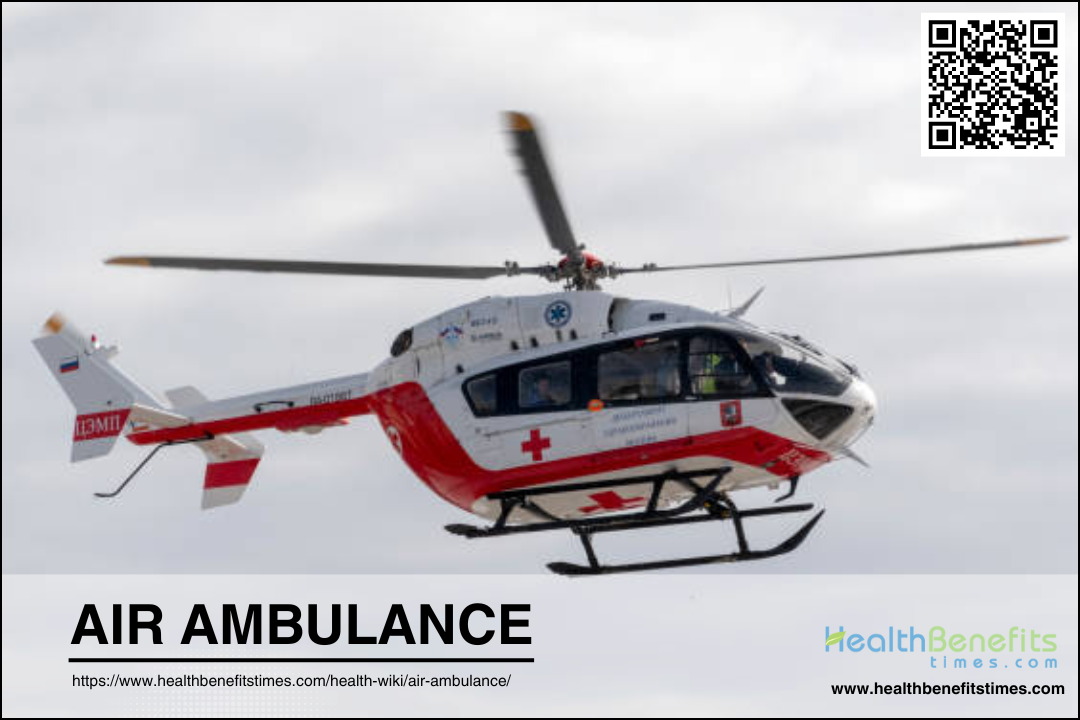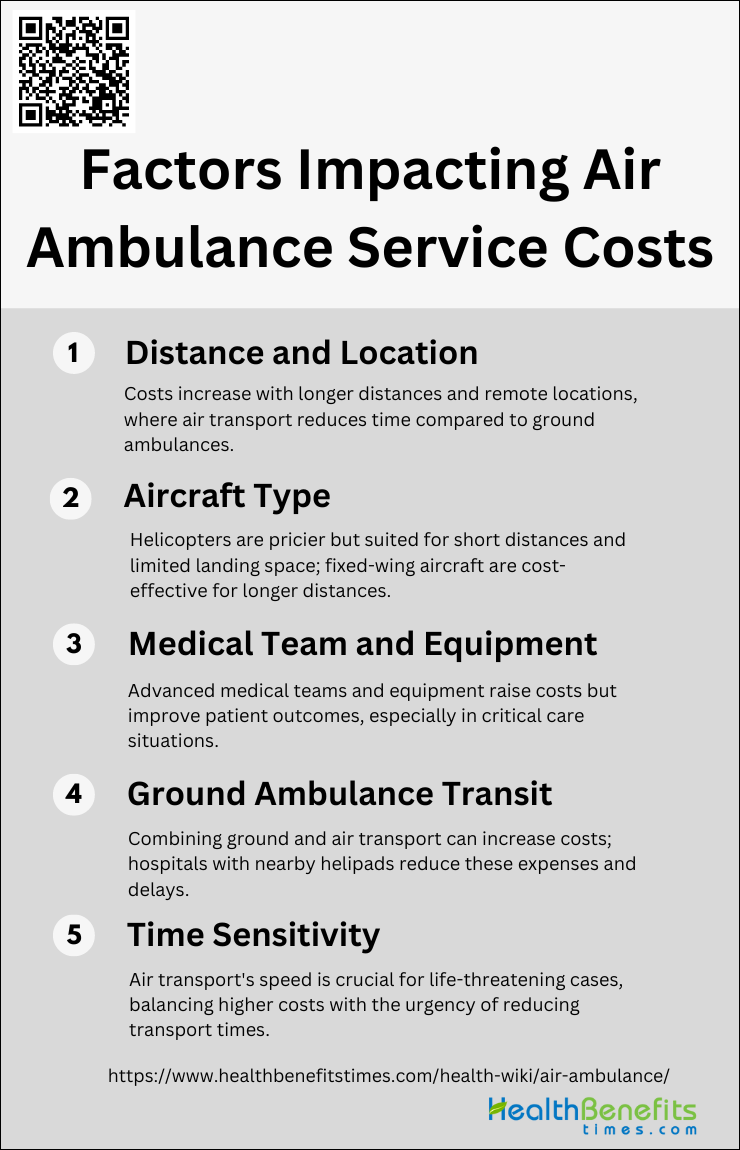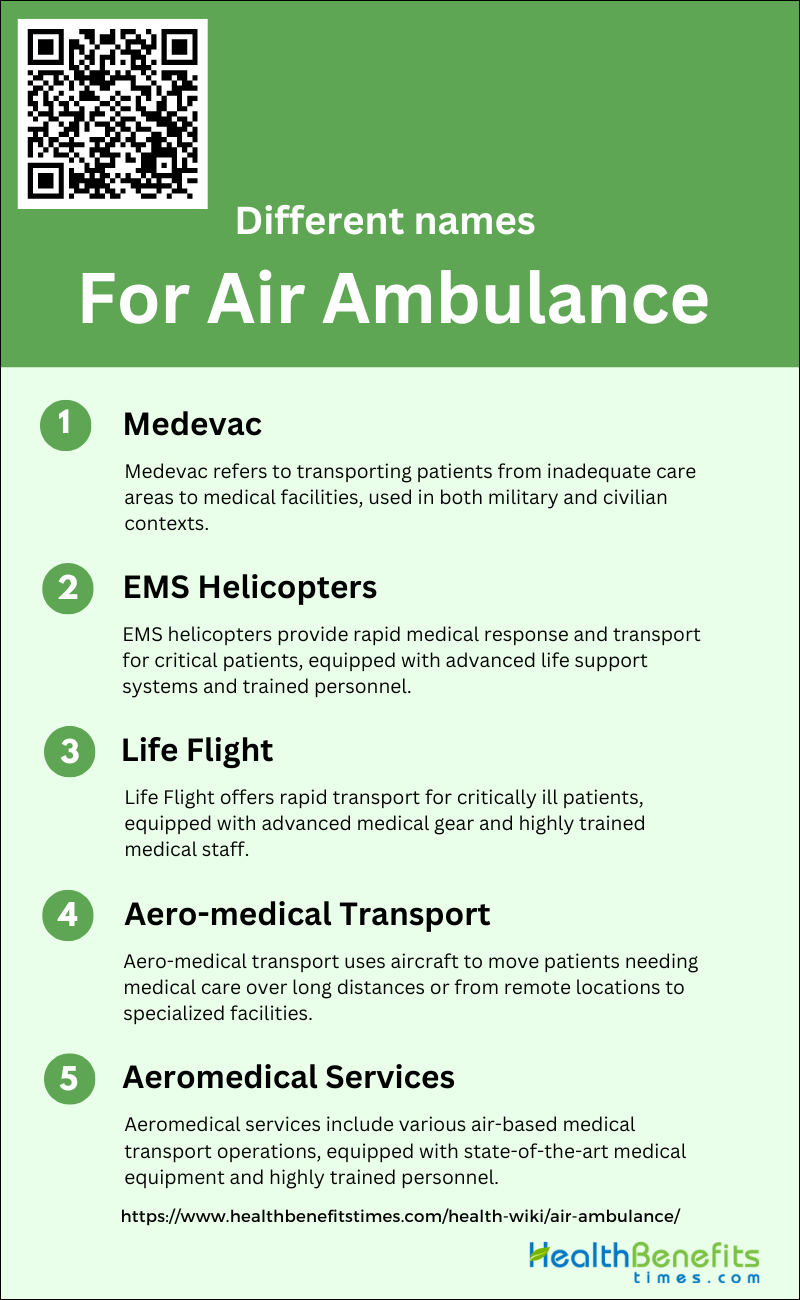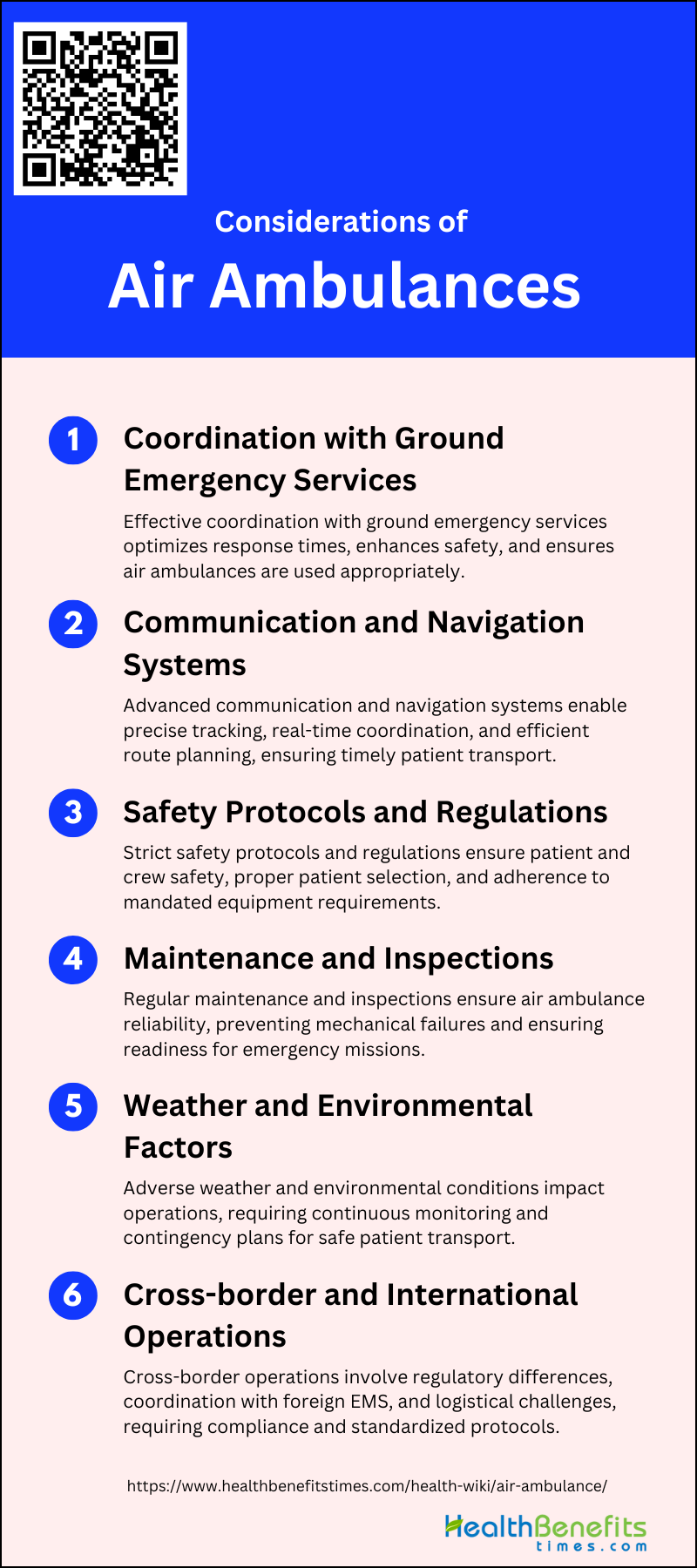 An air ambulance is a specially outfitted aircraft, either a helicopter or fixed-wing plane, designed to transport injured or sick individuals who require urgent medical care over distances or terrains that are impractical for conventional ground ambulances. These aircraft are equipped with advanced medical equipment such as ventilators, ECGs, monitoring units, and stretchers, allowing for intensive care during flight. Air ambulances are used in various scenarios, including medical emergencies, patient transfers between hospitals, and repatriation from foreign countries. They provide critical care and rapid transport, often receiving priority handling from air traffic control similar to ground ambulances with lights and sirens.
An air ambulance is a specially outfitted aircraft, either a helicopter or fixed-wing plane, designed to transport injured or sick individuals who require urgent medical care over distances or terrains that are impractical for conventional ground ambulances. These aircraft are equipped with advanced medical equipment such as ventilators, ECGs, monitoring units, and stretchers, allowing for intensive care during flight. Air ambulances are used in various scenarios, including medical emergencies, patient transfers between hospitals, and repatriation from foreign countries. They provide critical care and rapid transport, often receiving priority handling from air traffic control similar to ground ambulances with lights and sirens.
History of Air Ambulances
The history of air ambulances traces back to military innovations and has evolved significantly over the past century. It all started over seventy years ago with the use of primitive biplanes to transport patients, which sparked interest in both military and medical communities due to the ability to bypass battlefield obstacles. The first recorded use of a U.S. military air ambulance was in 1918, and during World War II, over 1.1 million soldiers were airlifted. The Korean War introduced helicopters to air medical transport (AMT), with over 20,000 battlefield evacuations, and this practice expanded during the Vietnam War with Operation Dustoff, which transported nearly 1 million injured individuals. The success of military helicopter evacuations led to the adoption of similar systems in civilian contexts by the early 1970s, with the first civilian helicopter emergency medical services (HEMS) program established in 1972. Today, air medical services play a crucial role in emergency medical systems, providing rapid trauma response and advanced life support directly at accident scenes. The continuous growth of aeromedical programs highlights their critical role in modern emergency medical care, despite ongoing evaluations of their efficacy, cost, and safety.
Types of Air Ambulances
These types of air ambulances are critical component of emergency medical services, providing rapid transport for patients in need of urgent care. These specialized aircraft are equipped with medical facilities and staffed by trained medical personnel, ready to deliver lifesaving interventions mid-flight. Here are two main types of air ambulances that serve different patient needs and circumstances:
1. Fixed-Wing (Airplane) Air Ambulances
Fixed-wing air ambulances, commonly known as airplane ambulances, are highly effective for long-distance patient transport. These aircraft are particularly advantageous for distances over 300 kilometers (186 miles), where they offer both cost and time efficiency compared to other transport methods. Fixed-wing air ambulances are equipped to handle high-acuity patients, making them suitable for critical care transport over extended distances. They can accommodate multiple patients and medical personnel, providing a stable environment for medical interventions during flight. The integration of fixed-wing aircraft into emergency medical services (EMS) systems has been shown to significantly reduce morbidity and mortality by ensuring timely transfer of patients to specialized care facilities.
2. Rotary-Wing (Helicopter) Air Ambulances
Rotary-wing air ambulances, or helicopters, are essential for rapid patient transport, especially in scenarios where ground transport is impractical or too slow. Helicopters are highly effective for moderate distances up to 400-500 kilometers (248-310 miles), offering the fastest response times in emergency situations. They are often deployed for high-acuity patients due to their ability to land in diverse terrains and closer to accident sites or hospitals. The flexibility and range of capabilities of helicopters make them invaluable in both urban and rural settings, providing a more versatile service compared to fixed-wing aircraft. Recent studies have shown a significant increase in the use of rotary-wing air ambulances, reflecting their critical role in modern EMS systems.
How Much Does Air Ambulance Cost?
In the United States, air ambulance charges were 4.1-9.5 times higher than what Medicare paid for the same services in 2016. A cost-effectiveness analysis comparing air and ground ambulances revealed that the total cost of transportation and treatment by air ambulance was $11,898.05, compared to $412.88 for ground ambulance, making air ambulance services approximately 26 times more expensive. In New South Wales, Australia, Helicopter Emergency Medical Services (HEMS) cost between $9,300 and $19,000 per mission, with total annual costs exceeding $50 million. These high costs are influenced by factors like the type of helicopter used, clinical staffing, and operational hours. On the other hand, in Turkey, a developing country, the cost per ambulance run was much lower at $163.00, highlighting the difference in costs between regions and types of ambulance services.
Factors Impacting Air Ambulance Service Costs
The cost of air ambulance services can be influenced by a multitude of factors, each adding layers of complexity to the final price. Understanding these elements is crucial for those considering or requiring emergency medical air transport. Below is a list of key factors that significantly impact the cost of air ambulance services.
1. Distance and Location
The distance and location of the patient significantly impact the cost of air ambulance services. Helicopter emergency medical services (HEMS) are often chosen for their ability to cover long distances quickly, especially in rural or remote areas where ground transport may be impractical or too slow. Studies have shown that air transport is more frequently used for patients located more than 35 miles from a trauma center, as it significantly reduces transport time compared to ground ambulances. However, the cost-effectiveness of HEMS decreases with shorter distances, making ground ambulances a more economical choice for distances under 250 kilometers.
2. Aircraft Type
The type of aircraft used in air ambulance services also plays a crucial role in determining costs. Helicopters are generally more expensive to operate than fixed-wing aircraft but are more effective for shorter distances and in areas where landing space is limited. Fixed-wing aircraft, on the other hand, are more cost-effective for longer distances and can cover greater distances more efficiently. The choice between rotor-wing and fixed-wing aircraft depends on the specific needs of the mission, including distance, terrain, and urgency.
3. Medical Team and Equipment
The composition of the medical team and the equipment on board significantly influence the cost of air ambulance services. Advanced medical interventions and skilled personnel are essential for improving patient outcomes, however they also increase operational costs. The presence of specialized medical equipment and highly trained staff, such as paramedics and trauma surgeons, can make HEMS a more expensive option compared to ground transport. However, these factors are crucial for providing high-quality care during transport, especially for critically injured patients.
4. Ground Ambulance Transit
The integration of ground ambulance services with air transport can also affect overall costs. In many cases, patients need to be transported from the scene of the injury to a landing site or from the landing site to a hospital, requiring coordination between ground and air services. This additional step can add to the total cost and time of the transport. Hospitals with helipads adjacent to emergency departments can reduce these costs and delays, making air transport more efficient.
5. Time Sensitivity
Time sensitivity is a critical factor in the decision to use air ambulance services. Helicopters and fixed-wing aircraft are often chosen for their ability to reduce transport times, which is crucial in life-threatening situations. The speed of air transport can significantly impact patient outcomes, particularly in cases of severe trauma where every minute counts. However, the urgency of the situation must be balanced against the higher costs associated with air transport, making it essential to evaluate the specific needs of each case.
Different names For Air Ambulance
In the realm of emergency medical services, the air ambulance plays a vital role in providing rapid transport for patients in critical condition. Known by various monikers around the world, these airborne lifesavers are an essential component of modern healthcare systems. Below is a list of different names for air ambulances that reflect their widespread use and importance.
1. Medevac (short for medical evacuation)
Medevac, short for medical evacuation, refers to the timely and efficient movement and en route care provided by medical personnel to the wounded being evacuated from the battlefield to medical treatment facilities (MTFs) using medically equipped vehicles or aircraft. This term encompasses both military and civilian contexts, where it is crucial for transporting patients from areas with inadequate medical care to facilities where essential and definitive care can be rendered. The use of aircraft in medevac operations significantly reduces transport time, which is critical for patient survival and recovery. For instance, the US Army’s medevac system, although largely unchanged since the Vietnam era, has been shown to improve survival rates when staffed with critical care-trained flight paramedics.
2. EMS Helicopters
Emergency Medical Services (EMS) helicopters are specialized aircraft used to provide rapid medical response and transport for critically ill or injured patients. These helicopters are equipped with advanced life support (ALS) systems and staffed by highly trained medical personnel, including paramedics and flight nurses. EMS helicopters play a vital role in prehospital emergency medical services, responding directly to accident scenes and transporting patients to trauma centers and other specialized facilities. The integration of EMS helicopters into the broader EMS system ensures that patients receive timely and appropriate care, which can significantly improve outcomes, especially in rural or hard-to-reach areas.
3. Life Flight
Life Flight is a term often used to describe air ambulance services that provide rapid transport for critically ill or injured patients. These services are equipped with advanced medical equipment and staffed by highly trained medical personnel, including paramedics, nurses, and sometimes physicians. Life Flight operations are crucial in both urban and rural settings, offering a lifeline for patients who require immediate medical attention that cannot be provided on the ground. The effectiveness of Life Flight services has been demonstrated in various studies, showing improved survival rates and better health outcomes for patients transported by air compared to those transported by ground ambulances.
4. Aero-medical Transport
Aero-medical transport involves the use of aircraft, both fixed-wing and helicopters, to transfer patients who require medical care during transit. This mode of transport is essential for moving patients over long distances or from remote locations to specialized medical facilities. Aero-medical transport services are equipped with advanced medical equipment and staffed by trained medical personnel who can provide critical care en route. The development of aero-medical transport has been influenced by military practices, which have been adapted for civilian use, leading to significant advancements in patient care and transport efficiency.
5. Aeromedical Services
Aeromedical services encompass a wide range of air-based medical transport operations, including medevac, EMS helicopters, and fixed-wing air ambulances. These services are designed to provide rapid and efficient medical transport for patients in need of urgent care. Aeromedical services are equipped with state-of-the-art medical equipment and staffed by highly trained medical personnel, ensuring that patients receive the best possible care during transit. The integration of aeromedical services into the broader healthcare system has been shown to improve patient outcomes, particularly in cases of severe trauma or critical illness.
Advantages of Air Ambulances
Air ambulances offer critical services that can mean the difference between life and death in emergency situations. They provide rapid transportation for patients in need of immediate medical attention, often in areas where ground ambulances cannot reach quickly. Below is a list of key advantages that air ambulances bring to the healthcare system.
1. Rapid Response
Air ambulances provide a rapid response to medical emergencies, significantly reducing the time it takes to reach patients in critical condition. Helicopter air ambulances (HAA) are particularly effective in trauma care, as they can quickly transport patients to facilities with greater capabilities and speed up the transfer to trauma centers. This rapid response is crucial in improving patient outcomes, especially in cases of severe trauma where every minute counts.
2. Accessibility
Air ambulances offer unparalleled accessibility, especially in regions where ground transportation is compromised. They can extract injured patients from hostile terrains and provide access to accident scenes in remote or disaster-stricken areas. This capability ensures that patients in hard-to-reach locations receive timely medical attention, which can be life-saving in critical situations.
3. Specialised Medical Care
Air ambulances are equipped with advanced medical equipment and staffed by skilled personnel, providing specialized medical care during transport. This includes advanced interventions such as extracorporeal membrane oxygenation (ECMO) and other critical care procedures. The availability of such specialized care during transport can significantly improve patient outcomes, particularly for those with severe injuries or medical conditions.
4. Time-Sensitive Transport
For patients requiring time-sensitive medical interventions, air ambulances offer a crucial advantage by reducing the time between healthcare facilities. Although HAA transport may not always reduce the total transport time, it minimizes the time patients spend between facilities, which is critical for trauma patients needing immediate care. This time-sensitive transport is essential for improving survival rates and outcomes in emergency medical situations.
5. Long-Distance Transport
Air ambulances are ideal for long-distance transport, especially for patients needing to be moved over large distances or from remote areas to better-equipped medical centers. Fixed-wing air ambulances, for example, can complete long-distance transports within hours, ensuring that patients receive the necessary medical care without delay. This capability is particularly beneficial for patients requiring specialized treatments not available locally.
6. Great Option for Serious Patients
For seriously ill or injured patients, air ambulances provide a critical lifeline. They offer advanced medical care and rapid transport, which are essential for improving survival rates and outcomes. Studies have shown that patients with severe conditions, such as abnormal respiratory rates or low Glasgow Coma Scale scores, benefit significantly from air ambulance transport, even when ground transport might be faster. This makes air ambulances a great option for serious patients needing immediate and specialized care.
7. Access to Remote Areas
This is particularly important in regions with inadequate road networks or geographical barriers. By offering rapid and efficient transport from remote areas to advanced medical facilities, air ambulances play a crucial role in improving healthcare accessibility and outcomes for patients in these regions.
Considerations and Challenges of Air Ambulances
It plays a critical role in emergency medical services, providing rapid transport for patients in need of urgent care. However, their operation comes with a unique set of considerations and challenges that must be navigated carefully. Below is a list of key factors that impact the effectiveness and efficiency of air ambulance services.
1. Coordination with Ground Emergency Services
Effective coordination between air ambulances and ground emergency services (GEMS) is crucial for ensuring seamless patient care and optimizing response times. Centralized communication centers play a pivotal role in this coordination, facilitating real-time information exchange and decision-making. Multi-agency emergency responses benefit significantly from such coordinated efforts, reducing the risk of miscommunication and enhancing overall safety. Additionally, integrating air medical services into regional EMS systems ensures that air ambulances are utilized appropriately, aligning with local and regional patient needs and resources. This integration helps in avoiding overuse and ensures that air ambulances are dispatched only when necessary.
2. Communication and Navigation Systems
Advanced communication and navigation systems are essential for the efficient operation of air ambulances. These systems enable precise location tracking, real-time communication with ground teams, and effective route planning, which are critical for timely patient transport. The development of protocols for basic and advanced cardiac life support in air terminals and aircraft further underscores the importance of robust communication systems. Moreover, the integration of multiagent systems for coordinating ambulances can significantly reduce transportation time by efficiently assigning resources based on real-time data. Such technological advancements ensure that air ambulances can navigate complex environments and reach patients swiftly.
3. Safety Protocols and Regulations
Safety protocols and regulations are fundamental to the operation of air ambulances, ensuring the safety of both patients and crew. Regulations have been developed to assure proper patient selection, quality care, and minimization of misuse of this expensive resource. The Federal Aviation Agency mandates specific equipment requirements for air ambulances, addressing various clinical problems that can arise at different altitudes. Additionally, the implementation of rigorous safety reviews and the discouragement of practices like helicopter shopping enhance overall safety. These measures collectively ensure that air ambulances operate within a framework that prioritizes safety and efficacy.
4. Maintenance and Inspections
Regular maintenance and inspections of air ambulances are critical to ensuring their reliability and safety. Technological improvements, such as reduced charge times and increased operational range, can enhance the reliability of electric vertical take-off and landing (eVTOL) aircraft, making them more viable for aeromedical transport. Adhering to stringent maintenance schedules and conducting thorough inspections can prevent mechanical failures and ensure that air ambulances are always ready for emergency missions. This proactive approach to maintenance not only extends the lifespan of the aircraft but also ensures the safety of patients and crew during transport.
5. Weather and Environmental Factors
Weather and environmental factors significantly impact the operation of air ambulances. Adverse weather conditions can delay or even prevent air ambulance missions, posing challenges to timely patient transport. The selection of the mode of transport often depends on weather conditions, with ground transport being preferred in unfavorable weather. Additionally, environmental factors such as terrain and visibility can affect the safety and efficiency of air ambulance operations. Therefore, continuous monitoring of weather conditions and having contingency plans in place are essential for mitigating these challenges and ensuring the safe transport of patients.
6. Cross-border and International Operations
Cross-border and international operations of air ambulances involve additional complexities, including regulatory differences, coordination with foreign EMS, and logistical challenges. Ensuring compliance with international aviation regulations and having protocols for interagency communication are crucial for the success of these operations. The integration of air medical services into regional and international EMS systems can facilitate appropriate utilization and coordination, ensuring that patients receive timely and effective care regardless of their location. Addressing these challenges requires a collaborative approach and the development of standardized protocols to streamline cross-border air ambulance operations.





